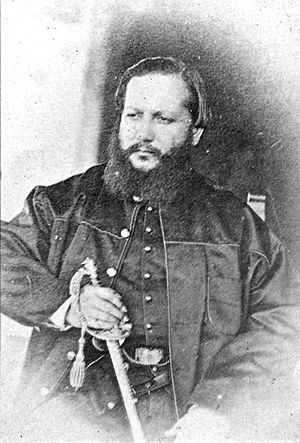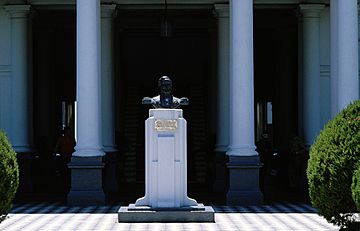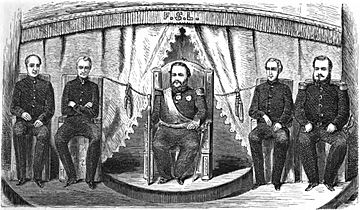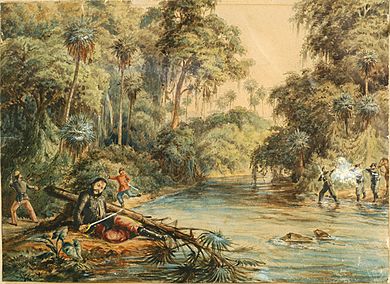Francisco Solano López facts for kids
Quick facts for kids
Francisco Solano López
|
|
|---|---|

López, c. 1870
|
|
| 2nd President of Paraguay | |
| In office 10 September 1862 – 1 March 1870 |
|
| Vice President | Domingo Francisco Sánchez |
| Preceded by | Carlos Antonio López |
| Succeeded by | Cirilo Antonio Rivarola |
| Personal details | |
| Born | 24 July 1826 Asunción, Paraguay |
| Died | 1 March 1870 (aged 43) Cerro Corá, Paraguay |
| Spouse | Eliza Alicia Lynch |
| Parent |
|
| Signature |  |
| Military service | |
| Allegiance | Paraguay |
| Branch/service | Paraguayan Army |
| Years of service | 1844–1870 |
| Rank | Marshal of the Paraguayan Armies |
| Commands |
|
| Battles/wars | Platine Wars:
|
| Awards |
|
Francisco Solano López Carrillo (born July 24, 1826 – died March 1, 1870) was a very important leader in the history of Paraguay. He served as the President of Paraguay from 1862 until his death in 1870. He was the oldest son of the previous president, Carlos Antonio López.
Even when he was very young, Francisco Solano López joined the Paraguayan Army. He fought in small conflicts between Paraguay and Argentina during the Platine Wars. After a leader named Juan Manuel de Rosas was no longer in power, López became an ambassador for Paraguay. He traveled to several countries in Europe from 1853 to 1855.
When he returned to Paraguay, his father made him Vice-President. After his father passed away, Francisco Solano López became president.
He is a very debated figure in South American history. This is mainly because of the Paraguayan War, also known as "the War of the Triple Alliance." Some people believe his goals caused the war. Others think he was a strong defender of South American nations against outside control. He fought until the very end of the war and was killed during the Battle of Cerro Corá.
Contents
Francisco Solano López: Early Life and Career
Growing Up and Joining the Army
Francisco Solano López was born in 1827 in a part of Asunción called Manorá. His father, Carlos Antonio López, became the President of Paraguay in 1841. When Francisco was just 17 years old, his father made him a brigadier general in the Paraguayan Army.
During the Argentine Civil Wars, young Solano López was put in charge of Paraguayan soldiers near the border with Argentina. He also studied military tactics in Rio de Janeiro and Asunción. He learned a lot about building forts and using artillery.
Traveling to Europe and Learning New Things
In 1853, Solano López was sent to Europe as a special representative for Paraguay. He visited Britain, France, and the Kingdom of Sardinia. He spent about a year and a half in Europe, mostly in Paris. He even went to Russia and watched the Crimean War to learn about military strategies.
While in Europe, he bought many weapons and military supplies for Paraguay. He also bought several steamships. He used what he learned to make the Paraguayan Army more modern. He adopted new ways of organizing the army, similar to what the French and Prussians did. He also helped set up a new railroad project and tried to bring French settlers to Paraguay. He even brought the first electric telegraph to South America!
López really admired the French Second Empire and was fascinated by Napoleon Bonaparte. He later designed army uniforms that looked like Napoleon's army. Some people even say he ordered a copy of Napoleon's crown, but this has not been proven.
During his time in France, Solano López met Eliza Lynch. She was from Ireland. He brought her back to Paraguay, and she became his partner and the unofficial first lady until his death.
Becoming Vice President and President
When Solano López returned from Europe in 1855, his father made him the Minister of War. In 1857, he was promoted to Vice President of Paraguay.
In 1859, López was on a Paraguayan ship that was captured by the British Navy. This happened because the British wanted his father to release a British citizen from prison.
When his father died in 1862, López called a meeting of the Congress of Paraguay. They all agreed to make him the new President of Paraguay for ten years.
Presidency and the Paraguayan War
López's Vision for Paraguay
As president, López continued many of his father's policies. These policies focused on protecting Paraguay's economy and developing the country from within. However, he changed Paraguay's approach to foreign countries. Before him, Paraguay had mostly stayed isolated. López wanted Paraguay to be a strong "third power" in South America. He wanted it to compete with the larger countries of Argentina and Empire of Brazil for influence in the Rio de la Plata Basin region.
López aimed to make Paraguay a major player. To do this, he tried to unite smaller nations in the region. He wanted them to form a group that could balance the power of Brazil and Argentina. He found a willing friend in Uruguayan President Bernardo Berro. Uruguay was often threatened by Brazil and Argentina. Berro and López quickly formed an alliance. López then began to greatly expand and reorganize the Paraguayan military. He made military service required for all men and introduced other changes.
Under López, Paraguay built one of the best-trained armies in the region. However, they were not well-equipped. He bought new weapons from France and England, but they did not arrive because of a blockade by the enemy when the war started.
How the War Started
In 1863, the Empire of Brazil supported a rebellion in Uruguay. This rebellion was led by Venancio Flores against the government of Bernardo Berro. The Uruguayan government asked Paraguay for help against the Brazilian-backed rebels. López sent a letter to Brazil, saying that if Brazil invaded Uruguay, Paraguay would see it as an attack on itself.
Brazil ignored the letter and invaded Uruguay on October 12, 1864. In response, López captured a Brazilian merchant ship in Asunción's harbor. He also imprisoned the Brazilian governor of Mato Grosso province, who was on board. The next month, López officially declared war on Brazil. He sent troops to invade Mato Grosso. His forces captured and looted the town of Corumbá. They also took control of the province and its diamond mines. They got a huge amount of weapons and ammunition. However, the Paraguayan forces did not capture the capital city of Cuiabá.
López then wanted to send soldiers to Uruguay to help the government there. But when he asked Argentina for permission to cross their land, President Bartolomé Mitre refused. By this time, Brazil had successfully overthrown the Uruguayan government and put their ally, Venancio Flores, in power. Uruguay became like a puppet state controlled by Brazil.
The Paraguayan Congress gave López the special title of "Marshal-President" of the Paraguayan Armies. He was the only Paraguayan to ever receive this rank during his lifetime. They also gave him special powers for the war. On April 13, 1865, López declared war on Argentina. He seized two Argentine warships and occupied the town of Corrientes. He set up a temporary government there and announced that Paraguay had taken over Corrientes Province and Argentina's Entre Ríos Province.
On May 1, 1865, Brazil, Argentina, and Uruguay signed the Treaty of the Triple Alliance. This treaty said they would fight Paraguay together until López's government was overthrown. It also said they would not stop fighting until Paraguay had no weapons left. This agreement was carried out completely. The treaty also stated that more than half of Paraguay's land would be taken by the Allies after the war. When the treaty became public, it caused anger around the world, and many people spoke out in support of Paraguay.
The War of the Triple Alliance
The war lasted until March 1, 1870. It was fought with great determination by both sides. López's army faced more and more problems. His first big defeat was on June 11, 1865. The Paraguayan fleet was destroyed by the Brazilian Navy at the Battle of Riachuelo. This gave the Allies control over the rivers around Paraguay and forced López to leave Argentina.
On September 12, 1866, López invited President Mitre to a meeting. López thought it was a good time to make peace and was ready to sign a peace treaty. However, they could not agree. Mitre insisted that all parts of the Treaty of the Triple Alliance must be followed. López refused these terms. The treaty said that the Allies would not stop fighting until López's government was overthrown.
In 1868, as the Allies pushed harder, López became convinced that his own supporters were plotting against him. Because of this, hundreds of important Paraguayan citizens were arrested and executed on his orders. This included his own family members, government officials, judges, military officers, and priests. Many foreigners were also killed, including some diplomats.
Ramona Martínez, a nurse during the war, was enslaved by López. She was known for her bravery in fighting and encouraging soldiers, earning her the nickname "the American Joan of Arc."
The Final Battle: Cerro Corá
Allied troops captured the capital city of Asunción on January 1, 1869. This forced López and the rest of his army to flee to the countryside. By late 1869, López was left with only a small group of soldiers near the northern border of Paraguay. He reached Cerro Corá on February 14, 1870.
Two groups of Allied soldiers were sent to find Solano López. He was with about 200 men in the forests. He heard that a large Brazilian force was getting close. This news caused some of his remaining officers to leave him and join the Allied force. They helped the Brazilian General José Antônio Correia da Câmara find López.
When López heard this, he called a last war council with his remaining officers. They had to decide whether to escape into the forest or stay and fight. The council decided to stay and fight until the end.
The Brazilian force reached López's camp on March 1. During the battle, López became separated from his army. He was only with his aide and a few officers. He had been badly wounded in the stomach and head. He was too weak to walk alone. They led him to a stream called Aquidabangui. His companions left him there, saying they would get help.
While López was alone with his aide, General Câmara arrived with six soldiers. Câmara told López to surrender and promised to spare his life. López refused. He shouted, ¡Muero con mi patria! ("I die with my nation!"), and tried to attack Câmara with his sword. Câmara ordered his soldiers to disarm López, but López died during the struggle. This moment marked the end of the War of the Triple Alliance.
What People Think About López Today
There is still a big debate in Paraguay about Francisco Solano López. Some people see him as a brave leader who fought until the very end. Others believe he foolishly led Paraguay into a war it could not win, almost wiping the country off the map.
However, many people in Latin America see him as a hero. They believe he fought for the rights of smaller nations against the power of larger ones. For example, writer Eduardo Galeano said that López and his father continued to protect Paraguay. He called Paraguay "the only country that foreign money had not changed."
Historians in Paraguay still debate López's exact last words. The two main versions are "Muero por mi patria" ("I die for my nation") or "Muero con mi patria" ("I die with my nation").

March 1 is a national holiday in Paraguay called "Dia de los Heroes" (Heroes' Day). It honors López's memory and is the most important holiday after Independence Day. López is still seen as Paraguay's greatest national hero. His remains are kept at the National Pantheon of the Heroes in Asunción. When something important happens in Paraguay, people often gather with their flags in front of the Pantheon to celebrate.
In 2007, Argentine President Cristina Kirchner named an Argentine military unit after Marshal Francisco Solano López. During the ceremony, the national anthems of both countries were sung, and high-ranking officers from both armies were there.
At the end of the ceremony, the Paraguayan Army Commandant gave the unit a portrait of López. A newspaper in Buenos Aires, La Nación, which was founded by Bartolomé Mitre, wrote an article with the headline "Absurd tribute to a dictator." The article said that naming a military unit after López was like France or Poland naming a regiment "Adolf Hitler."
Images for kids
See also
 In Spanish: Francisco Solano López para niños
In Spanish: Francisco Solano López para niños








